#tomb of the three foreign wives of thutmose III
Text

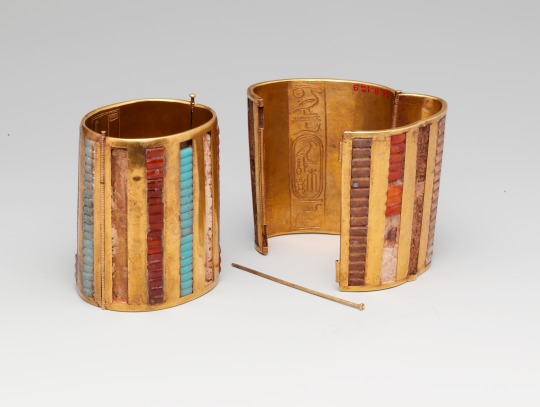
Hinged Cuff Bracelet - Met Museum Collection
Inventory Number: 26.8.130
New Kingdom, Dynasty 18, ca. 1479–1425 B.C.
Location Information: From Egypt, Upper Egypt, Thebes, Wadi Gabbanat el-Qurud, Wadi D, Tomb of the Three Foreign Wives of Thutmose III
Description:
Three pairs of hinged bracelets (26.8.125–.130) are associated with the tomb of three foreign wives of Thutmose III. They are all made of burnished gold inlaid with carnelian and glass that was originally turquoise and dark blue, but has faded. Each is inscribed on the inner surface with the cartouches and epithets of Thutmose III suggesting that they were a gift of the king.
#hinged cuff bracelet#bracelet#bracelets#new kingdom#new kingdom pr#dynasty 18#upper egypt#thebes#wadi gabbanat el-qurud#wadi d#tomb of the three foreign wives of thutmose III#met museum#26.8.130#jewelry#NKPRJ
1 note
·
View note
Text
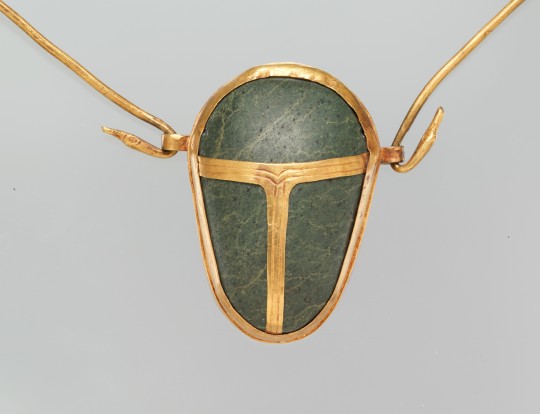
Ancient Egyptian heart amulet (gold and green schist) of one Manhata. Artist unknown; ca. 1479-1425 BCE (reign of Thutmose III, 18th Dynasty, New Kingdom). From the Tomb of the Three Foreign Wives of Thutmose III at Wadi Gabbanat el-Qurud, Thebes; now in the Metropolitan Museum of Art.
#art#art history#ancient art#Egypt#Ancient Egypt#Egyptian art#Ancient Egyptian art#Egyptian religion#Ancient Egyptian religion#kemetic#Thutmose III#18th Dynasty#New Kingdom#jewelry#jewellery#pendant#amulet#metalwork#gold#goldwork#schist#Egyptian Thebes#Metropolitan Museum of Art
684 notes
·
View notes
Text


~ Finger stall.
Period: New Kingdom, Dynasty 18; reign of Thutmose III
Date: ca. 1479–1425 B.C.
Place of origin: Egypt, Upper Egypt, Thebes, Wadi Gabbanat el-Qurud, Wadi D, Tomb of the Three Foreign Wives of Thutmose III
Medium: Gold
#ancient#ancient art#history#museum#archeology#ancient egypt#ancient sculpture#ancient history#archaeology#egyptology#egyptian#egypt#finger stall#finger#18th dynasty#new kingdom#thutmose iii#thebes#ca. 1479 b.c.#ca. 1425 b.c.#gold
457 notes
·
View notes
Text
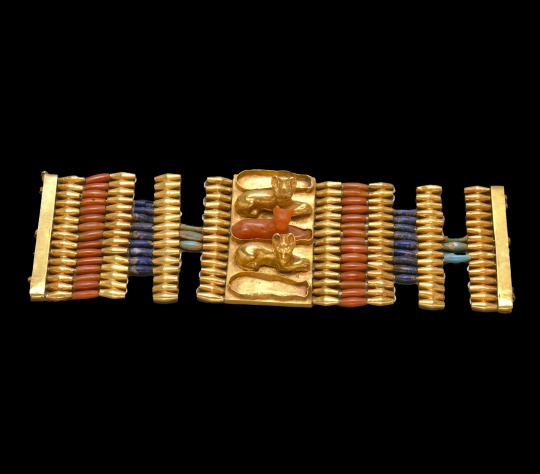
Ancient Egyptian cuffed bracelet with cats (gold, carnelian, lapis-lazuli, turquoise glass), c. 1479–1425 B.C.
Found within the Tomb of the Three Foreign Wives of Thutmose III, Wadi Gabbanat el-Qurud, Thebes, Egypt.
Met Museum. 26.8.121a
16 notes
·
View notes
Photo

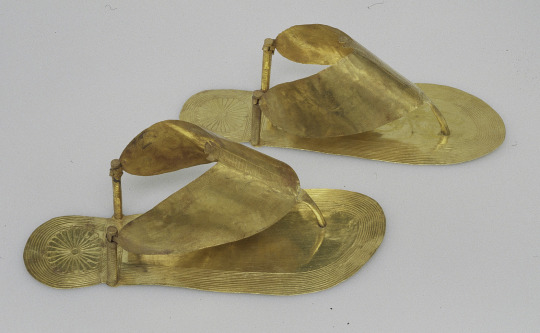

Sandals, ca. 1479–1425 B.C.E., New Kingdom, 18th Dynasty, Reign of Thutmose III, Thebes, Egypt, Wadi Gabbanat el-Qurud, Wadi D, Tomb of the Three Foreign Wives of Thutmose III, gold sheet, 25.5 x 9.5 cm, The Metropolitan Museum of Art.
39 notes
·
View notes
Photo
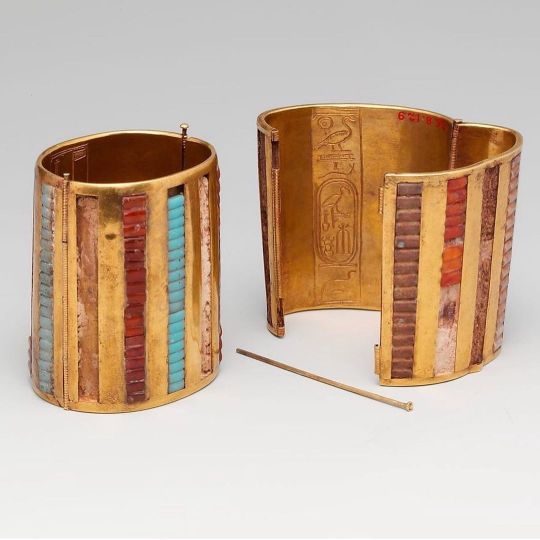
Hinged Cuff Bracelet (ca. 1479–1425 B.C.) Three pairs of hinged bracelets are associated with the tomb 𓂝𓂝𓇋𓉴 “ˁˁı͗” of three foreign wives 𓈞𓏏𓏫 “ḥm.tw” of Thutmose III. They are all made of burnished gold 𓋞 “nbw” inlaid with carnelian 𓁷𓂋𓋴𓏏𓈒𓏫 “ḥrst” and glass 𓃀𓆓𓏸𓅱 “bḏ” that was originally turquoise 𓅓𓆑𓂓𓏏𓏬 “mfk.t��� and dark blue 𓇋𓁹𓅂𓈒𓏫 “irtyw”, but has faded. Each is inscribed on the inner surface with the cartouches 𓍲𓈖𓏌𓅱𓍶 “šnw” and epithets of Thutmose III (𓅝𓄟𓊃𓄤𓆣𓏫) “ḏhwty-ms nfr-ḫprw” ‘Thutmoses (Born of Thoth), Beautiful of Forms’ suggesting that they were a gift of the king 𓇓𓏏𓈖 “nsw.t”. Translation: (Left) The Good God, Lord of the Two Lands, Menkheperre, Given Life. “nṯr-nfr nb t3wy mn-ḫpr-rˁ dı͗ rˁ” (Right) Son of Ra, of his body, Thutmoses-Beautiful of Form, Forever. “s3-rˁ n ḫt.f ḏhwty-ms nfr-ḫpr ḏ.t” Object Details Title: Hinged Cuff Bracelet Period: New Kingdom Dynasty: Dynasty 18 Reign: reign of Thutmose III Date: ca. 1479–1425 B.C. Geography: From Egypt, Upper Egypt, Thebes, Wadi Gabbanat el-Qurud, Wadi D, Tomb of the Three Foreign Wives of Thutmose III Medium: Gold, carnelian, turquoise, glass Dimensions: h. 7.2 cm (2 13/16 in); w. at top 6 cm (2 3/8 in); d. at top 4.8 cm (1 7/8 in). Location: Metropolitan Museum of Fine Arts 𓋹𓎬𓋹𓎬𓋹𓎬𓋹𓎬𓋹𓎬𓋹𓎬𓋹𓎬𓋹𓎬𓋹𓎬𓋹𓎬𓋹𓎬𓋹𓎬𓋹𓎬𓋹𓎬𓋹𓎬𓋹𓎬 📸 @egyptologylessons 𓋹𓊽𓋴𓆖𓎛𓇳𓎛 © (📸 @metmuseum and description) 𓊁𓊁𓊁𓊁𓊁𓊁𓊁𓊁𓊁𓊁𓊁𓊁𓊁𓊁𓊁𓊁𓊁 #Egypt #egyptian #ancient #ancientegypt #hieroglyphics #ägypten #thisisegypt #egyptologist #myegypt #egyptianhistory #egyptology #explore #hieroglyphs #madeinegypt #egypte #egyptians #egyptshots #loveegypt #discoveregypt #egitto #埃及 #مصر #egipto #explorepage #met #thutmosesiii #egyptianjewelery https://www.instagram.com/p/CeBkyqpu9fS/?igshid=NGJjMDIxMWI=
#egypt#egyptian#ancient#ancientegypt#hieroglyphics#ägypten#thisisegypt#egyptologist#myegypt#egyptianhistory#egyptology#explore#hieroglyphs#madeinegypt#egypte#egyptians#egyptshots#loveegypt#discoveregypt#egitto#埃及#مصر#egipto#explorepage#met#thutmosesiii#egyptianjewelery
16 notes
·
View notes
Photo

The handle of this mirror was originally made of wood (now restored) covered with gold foil. The woman's face with cow's ears represents the goddess Bat and is also an emblem of the goddess Hathor. The use of gold and silver, rather than wood and bronze, identifies this as the possession of a member of the elite, in this case one of three foreign wives of Thutmose III. The king's cartouche is inscribed above the face. �� mirror with Handle in the Form of a Hathor Emblem Period: New Kingdom Dynasty: Dynasty 18 Reign: reign of Thutmose III Date: ca. 1479–1425 B.C. Geography: From Egypt, Upper Egypt, Thebes, Wadi Gabbanat el-Qurud, Wadi D, Tomb of the Three Foreign Wives of Thutmose III Medium: Disk: silver; handle: wood (modern) sheathed in gold (ancient) Dimensions: H. 29.3 cm (11 9/16 in.); W. of disk 14.2 cm (5 9/16 in.); D. 3 cm (1 3/16 in.) #BritishMuseum #metmusueum #egypt #مصر #ancientegyptianjewelery #MuseumFromHome #bkmegyptianart #ancientring #Egypt #AncientEgyptian #JewelryAncientEgyptian #Jewelleryancientegyptian #ringsancientegyptian #scarabsrings #scarabs #16thcentury #15thcentury #14thcentury #newkingdom #jewellerybloger #instajewelry #egyptological #egyptianjewelry #tutankhamon https://www.instagram.com/p/CZAcNo1siNt/?utm_medium=tumblr
#britishmuseum#metmusueum#egypt#مصر#ancientegyptianjewelery#museumfromhome#bkmegyptianart#ancientring#ancientegyptian#jewelryancientegyptian#jewelleryancientegyptian#ringsancientegyptian#scarabsrings#scarabs#16thcentury#15thcentury#14thcentury#newkingdom#jewellerybloger#instajewelry#egyptological#egyptianjewelry#tutankhamon
0 notes
Photo

In Theban tomb paintings dating to Dynasty 18, servants are sometimes shown anointing guests with perfumed oils and ointments stored in small stone jars. A set of cosmetic jars highlighted with gold foil (26.8.29a, b–26.8.39) are associated with the grave goods of three foreign wives of Hatshepsut’s nephew, Thutmose III. Most of these vessels are inscribed with the king’s cartouche, marking them as royal gifts.
The inscription on this jar reads: “the Good God, Menkheperre (Thutmose III).”
See additional object information
10 notes
·
View notes
Photo

The Body Transformed’ exhibition at the MET
Gold Sandals and toe stalls (left)
Egyptian, Tomb of the Three Foreign Wives of Thutmose III, Thebes, New Kingdom, Dynasty 18, ca. 1479–1425 B.C.
Bone Cuff (right)
America, 1971–74, Sterling silver
0 notes
Text

Cuff Bracelet with Cat Amulets - Met Museum Collection
Inventory Number: 26.8.122a–e
New Kingdom, Dynasty 18, ca. 1479–1425 B.C.
Location Information: From Egypt, Upper Egypt, Thebes, Wadi Gabbanat el-Qurud, Wadi D, Tomb of the Three Foreign Wives of Thutmose III
#Cuff Bracelet with Cat Amulets#bracelet#bracelets#jewelry#new kingdom#new kingdom pr#dynasty 18#upper egypt#thebes#wadi gabbanat el qurud#wadi gabbanat el-qurud#tomb of the three foreign wives of thutmose III#met museum#26.8.122a#NKPRJ
1 note
·
View note
Text

Broad collar of Nefer Amulets - Met Museum Collection
Inventory Number: 26.8.135a
New Kingdom, Dynasty 18, ca. 1504–1450 B.C.
Location Information: From Egypt, Upper Egypt, Thebes, Wadi Gabbanat el-Qurud, Wadi D, Tomb of the Three Foreign Wives of Thutmose III
Description:
The "nefer" hieroglyph signifies the word meaning "good" or "beautiful," so perhaps this necklace was meant to bring good wishes to the wearer. A collar of this size and craftsmanship belonged to a member of the upper class - in this case, a wife of Thutmose III.
#Broad collar of Nefer Amulets#broad collar#broad collars#jewelry#new kingdom#new kingdom pr#dynasty 18#upper egypt#thebes#wadi gabbanat el-qurud#wadi gabbanat el qurud#tomb of the three foreign wives of thutmose III#met museum#26.8.135a#NKPRJ
0 notes
Text







Diadem with a Pair of Gazelle Heads - Met Museum Collection
Inventory Number: 26.8.99
New Kingdom, Dynasty 18, early, ca. 1479–1425 B.C.
Location Information: From Egypt, Upper Egypt, Thebes, Wadi Gabbanat el-Qurud, Wadi D, Tomb of the Three Foreign Wives of Thutmose III
Description:
During her lifetime, a queen wore this delicate diadem tied over her wig. The headband not only identified her elite rank but also identified her as a woman participating in a cultic performance. Tomb depictions illustrate high-ranking women wearing similar ornaments when they took part in rituals that likely honored important goddesses like Hathor, Mut, or Sakhmet. The reason for depicting gazelles is not clear, although they are associated with the sun god, fertility, and rebirth—all subjects connected to these great goddesses. Gazelles inhabit the low desert along the edge of the Nile’s floodplain, often traveling in pairs. This habitat probably explains why these animals figure prominently in a significant myth about the goddesses that takes place in that setting.
#Diadem with a Pair of Gazelle Heads#diadem#diadems#new kingdom#new kingdom pr#dynasty 18#upper egypt#thebes#wadi gabbanat el qurud#wadi gabbanat el-qurud#wadi D#tomb of the three foreign wives of thutmose III#hats#NKPRH#NKPRJ#met museum#26.8.99
1 note
·
View note
Text

Ensemble of Rosettes - Met Museum Collection
Inventory Number: 26.8.117a
New Kingdom, Dynasty 18, ca. 1479–1425 B.C.
Location Information: From Egypt, Upper Egypt, Thebes, Wadi Gabbanat el-Qurud, Wadi D, Tomb of the Three Foreign Wives of Thutmose III
Description:
These rosettes from the funerary equipment of three foreign wives of Thutmose III have been diplayed in various ways, since they came to the Metropolitan Museum in 1926. Most familiar to previous viewers is their reconstruction as part of a wig cover with 26.8.117bb as the head piece. Such a cover was first suggested by Herbert E. Winlock in 1937 and later modified. According to present understanding, the joining of the rosettes to the gold disk 26.8.117bb, and the use of strands of rosettes as a wig cover are uncertain.
#Ensemble of Rosettes#met museum#upper egypt#thebes#Wadi Gabbanat el-Qurud#wadi d#Tomb of the Three Foreign Wives of Thutmose III#new kingdom#new kingdom pr#dynasty 18#26.8.117a#womens hair and wigs#hats#jewelry#NKPRWHW#NKPRH#NKPRJ
0 notes
Text


Cuff Bracelets Decorated with Cats - Met Museum Collection
Inventory Number: 26.8.121a
New Kingdom, Dynasty 18, ca. 1479–1425 B.C.
Location Information: From Egypt, Upper Egypt, Thebes, Wadi Gabbanat el-Qurud, Wadi D, Tomb of the Three Foreign Wives of Thutmose III
Description:
The cats on this bracelet are similar to elements of royal jewelry dating to the beginning of Dynasty 18. The animal was sacred to the goddess Bastet, the benign counterpart of Sakhmet who incorporated the fierceness of a lioness.
#Cuff Bracelets Decorated with Cats#bracelet#bracelets#jewelry#new kingdom#new kingdom pr#dynasty 18#upper egypt#thebes#wadi gabbanat el qurud#wadi gabbanat el-qurud#wadi di#tomb of three foreign wives of thutmose iii#met museum#26.8.121a#NKPRJ
0 notes
Text

Hinged Cuff Bracelet - Met Museum Collection
Inventory Number: 26.8.125
New Kingdom, Dynasty 18, ca. 1479–1425 B.C.
Location Information: From Egypt, Upper Egypt, Thebes, Wadi Gabbanat el-Qurud, Wadi D, Tomb of the Three Foreign Wives of Thutmose III
#Hinged Cuff Bracelet#bracelets#jewelry#new kingdom#dynasty 18#upper egypt#thebes#Wadi Gabbanat el-Qurud#Wadi Gabbanat el Qurud#wadi d#tomb of three foreign wives of thutmose III#NKPRJ#met museum#26.8.125
0 notes
Text

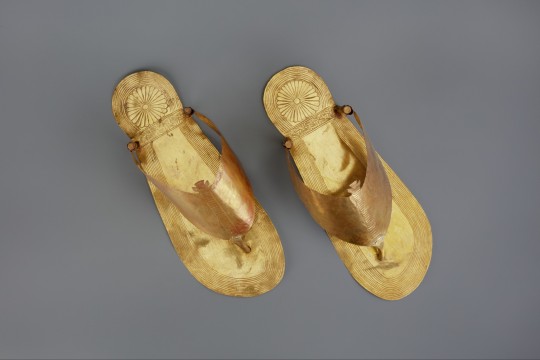

~ Sandals.
Period: New Kingdom, 18th Dynasty; Reign of Thutmose III
Date: ca. 1479–1425 B.C.
Place of origin: Egypt, Thebes, Wadi Gabbanat el-Qurud, Wadi D, Tomb of the Three Foreign Wives of Thutmose III
Medium: Gold sheet
#ancient#ancient art#history#museum#archeology#ancient egypt#ancient history#archaeology#egyptian#egypt#egyptology#sandals#gold#new kingdom#18th dynasty#thutmose iii#ca. 1479 b.c.#ca. 1425 b c.
1K notes
·
View notes